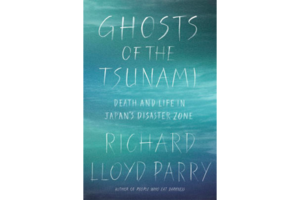'Ghosts of the Tsunami' humanizes the survivors of Japan's 2011 catastrophe
'Ghosts' is less an analytical or journalistic account than it is a character-driven, novelistic narrative about loss and trauma.

Ghosts of the Tsunami
By Richard Lloyd Parry
Farrar, Straus and Giroux
320 pp.
I started reading Ghosts of the Tsunami half-expecting to be bored. Not because of its author, Richard Lloyd Parry, the Asia editor and Tokyo bureau chief for the Times of London, who over the course of three books has proven himself an excellent reporter and writer. But as a fellow expat and journalist in Japan, I have already seen so many stories and documentaries about its subject – Japan’s 2011 tsunami. I have visited the devastated region, interviewing survivors and public officials for media in the US and Japan. Aside from some updated statistics and reportage, I couldn’t imagine the book would tell me anything I didn’t already know.
I was wrong from page one. “Ghosts” is less an analytical or journalistic account than it is a character-driven, novelistic narrative about loss and trauma in a community disfigured by tragedy. While it is filled with meditations on the rituals and possible meanings of death, it begins with a new life.
On the morning of the disaster, the author views an ultrasound image of his second child in his wife’s womb, “a well-formed, unearthly face, which gave a charming and very human yawn.” What should have been an anticlimactic afternoon for him in his Tokyo office is jolted into fear and the panic of self-preservation. The quake begins to churn, and Lloyd Parry records his second-by-second tweets, concluding with the ominous, “strongest I’ve known in 16 yers [sic],” before ducking under his desk as the blinds rattle loudly and the building sways and groans.
Opening in the first-person voice helps ease non-Japanese readers into a cultural milieu studded with names (Sayomi, Takahiro) and locations (Tohoku, Ishinomaki) that they might not easily recognize or remember. But it also serves a more resonant function. Lloyd Parry, a tall, lean, blue-eyed British expat who has lived in Tokyo for over two decades, remains a visual and linguistic outsider in his adopted homeland, and doubly so in Japan’s hinterlands, hundreds of miles north. His presence in the story and detached but persistent curiosity about a tiny rural town paradoxically lends the book a broader cultural scope. As with Truman Capote’s “In Cold Blood,” the author is complicit with the reader: We don’t know these people who at first seem so different. But through unflinching observation and patience, we can begin to understand the emotions that connect.
The story is built around a mystery. Roughly 18,500 people perished in the tsunami, but only 75 children died while at school. Seventy-four of them died at one school.
That school, Okawa Elementary in Ishinomaki, has been the subject of several fly-by-night reports that highlight the awful without enlightening. A scamper up a rugged but navigable nearby hill could have saved all from the incoming wave. But the children were marched by their teachers and administrators to a low-lying traffic island, following vague protocol. The wave devoured them.
Lloyd Parry pursues the mystery with a detective’s doggedness. The passive blame of "mistakes were made" won’t do for bereft parents and relatives. Who are the responsible, and who are the victims? What really happened that afternoon? How could so many children die in one of Japan’s proudest architectural achievements: Schools that are built to strict codes meant to withstand natural disasters?
Three subjects are main characters: Naomi Hiratsuka, who learns how to operate an excavator to find the remains of her daughter in the rubble; Sayomi Shito, who resorts to licking the mud from her daughter’s corpse when two towels become saturated; and Junji Endo, a middle-aged teacher at the school who survives, dazed, but whose personal accounts of his escape don’t add up. Endo is the cipher at the core of the book’s inconsolable narrative: He saved himself amid a catastrophe, children died on his watch – and he is unable or unwilling to talk about it.
Japanese were admired in the aftermath of the 2011 disasters. Videos showed lines awaiting water, being turned away, and heading home peacefully without selfish rancor. But “Ghosts” reveals an undertow of rage and distrust in unforced, metaphorical lyricism. A river swollen by the tsunami wave: “The surface of the water was bulging and flexing like the muscles beneath the skin of an athlete.” When calm returns after the wave recedes: “Like a reflection in water after ripples, normality seemed to be steadily reasserting itself.”
Yes, there are plenty of ghosts: Taxi drivers report collecting passengers who disappear at the ruined destination. Lost wives, children and husbands appear and vanish on beaches. One unemployed man who didn’t suffer directly from the tsunami sees Hieronymus Bosch-like parades of dead and dying humans and animals. They make him hysterical, so unbearable that his wife and mother leave him in distress. But Lloyd Parry’s real achievement is to humanize the survivors of the catastrophe, to infuse their haunted lives with intimately recognizable humanity.
Roland Kelts is author of "Japanamerica: How Japanese Pop Culture Has Invaded the U.S."

